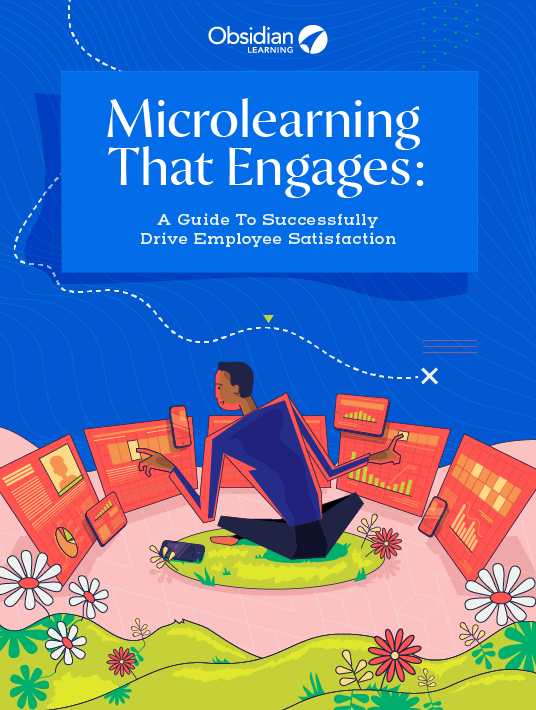How To Drive Employee Satisfaction Using Microlearning As A Methodology
More so perhaps than in other industries, Learning and Development is subject to a trend cycle. Microlearning and its trusty companion microcontent are trends that aren't going to fade anytime soon. The eBook I am going to talk about explains why that is the case. Microlearning—done right—is a winning long-term proposition because it both engages employees and boosts your organization's bottom line. But how do you it right?

About The eBook
At this point, I am going to breakdown what the eBook entails and how it is built up. Chapter 1 establishes a framework for what Obsidian means when they say “microlearning,” and discusses how it can drive employee engagement. Chapter 2 then explains how microlearning can increase employee satisfaction and knowledge retention. The focus shifts slightly in Chapter 3, which examines the elements that are essential to creating engaging microcontent. Chapters 4 and 5 take a look at the social aspects of microlearning. Chapter 4 discusses how microcontent can be adapted to address employees’ social needs. While Chapter 5 demonstrates how social learning can be the basis for creating microlearning videos. Any good learning strategy must be able to make a business case for its continued use; Chapter 6 explains how microlearning can improve corporate training ROI. Chapter 7 provides a roadmap for using employee satisfaction KPIs to evaluate the effectiveness of your microlearning strategy. Finally, Chapter 8 walks through the issues to consider before selecting a microlearning platform that is uniquely suited to your organization’s learning needs. Throughout this eBook, there are case studies, too, useful tips, and concrete strategies. According to Obsidian, microlearning is here to stay.
They don't only define what microlearning is, they also:
- Go beyond the definition of microlearning by focusing on its effective application in the realm of employee education and development.
- Explore the different kinds of microlearning and go in greater detail than “a short online learning module” by presenting and describing specific solutions and their associated learning context.
- Highlight the importance of microlearning in the ecosystem of learning assets by illustrating how ideal learning design always integrates fit-for-purpose microlearning.
As learning professionals, executives, human resource representatives, as well as operations managers and sales directors, we all strive to equip our employees and coworkers with the most relevant information and skills so they can perform in their job role as smoothly and effectively as possible. At least, that’s the ideal scenario. Doing it right is another story altogether. Halfway the eBook, you will have a clear understanding of what microlearning is. You will be able to understand how it can be helpful in terms of employee satisfaction and retention. Employees expect in-house microcontent to be like their experience on Google and YouTube, but customized to the company, and perhaps even their job role.
They touched briefly on the social aspect of microlearning in Chapter 3. After that, they dig deeper into how your microcontent can be adapted to fit your employee’s social needs better. Human beings have many needs that must be addressed on a day-to-day basis. One of these is social needs. Though not as essential as the need for food, water, and shelter, the desire to belong to a community, to build positive relationships with others, is high on our list of priorities. Many of us fulfill at least part of our social needs through work. A positive work environment fosters that sense of belonging, and in turn, creates happier, more productive employees.
They very clearly stress the importance of addressing social needs at work, and how you can use your microcontent to both educate and to engage/build community. At some point, they narrow the focus specifically on the medium of learning videos as microcontent as it can adapt to support social learning. Social learning is most generally defined as learning with and through others. Social learning theory posits that we learn by observing others’ behavior and the consequences of that behavior. Then we think about, process, and imitate that behavior. We receive feedback which reinforces or diminishes our new behavior.
Corporate training is often the first area where budgets are trimmed when there needs to be a budget cut. Organizations cut down on travel, lodging, and often put the brakes on developing new training. As a learning professional, microlearning is the perfect vehicle to propose to your clients under these circumstances. Done right, it’s simple, cost-effective, and—when all the micro pieces are strung together—it can be the foundation for a larger-scale learning program.
Making The Right Microlearning Choices
At this point, I am sure that you are convinced of the value of microlearning. You will learn what it is, how it can benefit your organization, and how you can evaluate its success both from a financial and employee satisfaction perspective. You will learn which platform you’re going to choose to deliver your content. Microlearning encompasses so many options and variations—it can feel complicated to make such choices. When trying to determine what’s most important and where to start, look first at your microlearning platform. To get going, download the eBook Microlearning That Engages: A Guide To Successfully Drive Employee Satisfaction. I am sure it will be of use to you.








